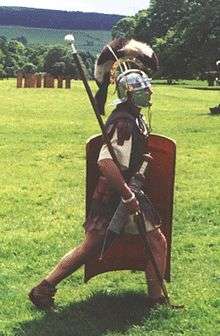Optio

 | ||||
| Part of a series on the | ||||
| Military of ancient Rome | ||||
|---|---|---|---|---|
| Structural history | ||||
|
||||
| Campaign history | ||||
| Technological history | ||||
|
||||
| Political history | ||||
|
|
||||
| Strategy and tactics | ||||
|
||||
|
| ||||
An optio (plural optiones; Latin: optio, optiōnēs, from optāre, "to choose", because an optio was chosen by his centurion), sometimes anglicized option (though rarely, to avoid confusion with "option"), was a soldier in the Roman army who held a position similar to that of a company's executive officer in modern armies. The optio seems to have held a rank roughly equivalent to that of a modern lieutenant, reflective of his status as the second in command of the century in which he served. The main function of an optio was as an optio centuriae, the second-in-command of a century, although there were many other positions an optio could hold.
Optiones were vital units in the Roman army. An optio was stationed at the rear of the ranks to keep the troops in order. Their duties would include enforcing the orders of the centurion, taking over the centurion's command in battle should the need arise, supervising his subordinates, and a variety of administration duties.
Optio pay was double the standard legionary pay and they were the most likely men to replace the centurion if the position became vacant.
Types of optio
Titles held by optiones included:
- Optio ad carcerem: chosen man on prison duty (incarceration).
- Optio ad spem ordinis: optio being groomed for promotion to the rank of centurion.
- Optio candidatus: optio being groomed or marked out for promotion to the rank of centurion.
- Optio carceris: soldier in charge of the prison cells.
- Optio centuriae: 'chosen man of the centuria'; second-in-command and rear rank officer of a centuria; classed as a duplicarius, a soldier receiving double basic pay; he carried a hastile (wooden staff).
- Optio centurionis: 'chosen man of the centurion'; same as optio centuriae.
- Optio custodiarum: soldier in charge of guard posts.
- Optio draconarius: 'chosen man among the dragon bearers', a late Roman senior standard bearer.
- Optio equitum: optio in the legionary or Praetorian cavalry (equus=horse).
- Optio fabricae: soldier in charge of a workshop.
- Optio navaliorum: soldier in charge of boats.
- Optio praetorii: soldier attached to headquarters.
- Optio principalis: optio who held supervisory rank (principales from the 2nd century onwards); not all who had the title of optio held this status.
- Optio speculatorum: optio in the elite cavalry bodyguards.
- Optio spei: optio being groomed for promotion to the rank of centurion.
- Optio statorum: optio of military police.
- Optio tribuni: assistant to a tribune.
- Optio valetudinarii: orderly in charge of a hospital.
Uniform
Unlike the centurion, the cuirass was not the distinguishing part of the optio's uniform. The identifying part would be his helmet; this would have had plumes of horse hair or feathers on either side of his helmet that could be accompanied by a helmet crest.
An optio's armour would be more like those of the common legionary. He could wear the lorica segmentata or a lorica hamata as well as have his gladius on the right not left side. One thing that did separate him from the common legionary was the staff (called a hastile), which was used to keep the legionaries in line. This staff would be roughly as tall as the optio himself. Optiones often carried wax tablets on which they kept the orders of the day.
Vegetius about Optiones
The Optiones are subaltern officers, so denominated from their being selected by the option of their superior officers, to do their duty as their substitutes or lieutenants in case of sickness or other accident. (Vegetius. De Re Militari, [1] II)